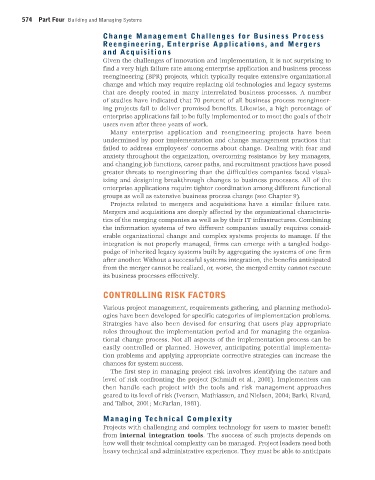Page 575 -
P. 575
574 Part Four Building and Managing Systems
Change Management Challenges for Business Process
Reengineering, Enterprise Applications, and Mergers
and Acquisitions
Given the challenges of innovation and implementation, it is not surprising to
find a very high failure rate among enterprise application and business process
reengineering (BPR) projects, which typically require extensive organizational
change and which may require replacing old technologies and legacy systems
that are deeply rooted in many interrelated business processes. A number
of studies have indicated that 70 percent of all business process reengineer-
ing projects fail to deliver promised benefits. Likewise, a high percentage of
enterprise applications fail to be fully implemented or to meet the goals of their
users even after three years of work.
Many enterprise application and reengineering projects have been
undermined by poor implementation and change management practices that
failed to address employees’ concerns about change. Dealing with fear and
anxiety throughout the organization, overcoming resistance by key managers,
and changing job functions, career paths, and recruitment practices have posed
greater threats to reengineering than the difficulties companies faced visual-
izing and designing breakthrough changes to business processes. All of the
enterprise applications require tighter coordination among different functional
groups as well as extensive business process change (see Chapter 9).
Projects related to mergers and acquisitions have a similar failure rate.
Mergers and acquisitions are deeply affected by the organizational characteris-
tics of the merging companies as well as by their IT infrastructures. Combining
the information systems of two different companies usually requires consid-
erable organizational change and complex systems projects to manage. If the
integration is not properly managed, firms can emerge with a tangled hodge-
podge of inherited legacy systems built by aggregating the systems of one firm
after another. Without a successful systems integration, the benefits anticipated
from the merger cannot be realized, or, worse, the merged entity cannot execute
its business processes effectively.
CONTROLLING RISK FACTORS
Various project management, requirements gathering, and planning methodol-
ogies have been developed for specific categories of implementation problems.
Strategies have also been devised for ensuring that users play appropriate
roles throughout the implementation period and for managing the organiza-
tional change process. Not all aspects of the implementation process can be
easily controlled or planned. However, anticipating potential implementa-
tion problems and applying appropriate corrective strategies can increase the
chances for system success.
The first step in managing project risk involves identifying the nature and
level of risk confronting the project (Schmidt et al., 2001). Implementers can
then handle each project with the tools and risk management approaches
geared to its level of risk (Iversen, Mathiassen, and Nielsen, 2004; Barki, Rivard,
and Talbot, 2001; McFarlan, 1981).
Managing Technical Complexity
Projects with challenging and complex technology for users to master benefit
from internal integration tools. The success of such projects depends on
how well their technical complexity can be managed. Project leaders need both
heavy technical and administrative experience. They must be able to anticipate
MIS_13_Ch_14_global.indd 574 1/17/2013 2:31:59 PM

